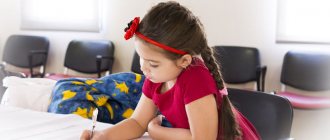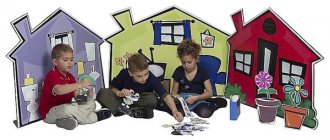Aesthetic education makes an important contribution to the implementation of all types of education, has a formative influence on the development of personality, and lays the foundations of morality. Knowledge about nature and society would also not be so complete if it had not passed through the prism of aesthetic perception.
Among the means of aesthetic education, three interdependent groups are distinguished:
- Environment. This includes the aesthetics of everyday life in a family, a preschool institution, the beauty of nature, harmonious relationships among members of groups where the child exists.
- Art, all its forms.
- Personal creative and artistic activity of children, not limited to one area.
The importance of teacher-parent interaction
The new educational philosophy, which asserts the primacy of parental responsibility over the responsibility of teachers in school and preschool institutions, cannot be called so new. The family has always determined the individual and his further life path. It’s just that at the time when the primacy of the public over the personal was proclaimed, they tried to forget about it. Now we have returned to the understanding that social institutions only support and continue the character, behavior patterns, and tastes established in the family.
note
The main task of parents and teachers in the educational process is interaction based on trusting relationships. Parents develop the child in the chosen direction, teachers deepen and correct the process in close cooperation with older family members.
The first social institution, a kindergarten, becomes a center that collaborates with other pedagogical and cultural institutions and involves parents in the educational process. barely emerging problems through the family, using a differentiated approach.
Family is the main factor in aesthetic education
The specific influence of the family team is a prerequisite for the comprehensive and timely development of the individual. The child’s horizons gradually expand, first experience is acquired, first work skills are mastered, the ability to organize leisure time is acquired, and a future family man is raised.
For full aesthetic development, a child must first develop an emotional sphere.
Aesthetic sensitivity is established already in those moments when the baby sees the mother’s face, reaches out to a bright toy, and dances to the sounds of rhythmic music. Accusing adult children of callousness and emotional unresponsiveness, parents forget that they once did not react to the child’s enthusiastic exclamations about a fluttering butterfly, did not stop to admire the flower, and did not pay attention to the life of the anthill.
The family lays the foundations of observation, which enriches the understanding of objects, their shape, color, differences and similarities.
Aesthetic sensitivity develops when parents attract the baby’s attention with a cloud in the sky, the color of leaves on a tree, or the festive decoration of city streets. Today, the child chooses a cup by color and pattern and tries not to break it. Tomorrow he will be selective towards many “adult” things and phenomena, will be able to justify his choice, give them an aesthetic assessment. Thoughtful organization of creative activities - what is available to the father and mother will become a solid foundation for the personality in the future.
Forms of organization
How can the educational process be organized? There are standard forms and methods of aesthetic education for younger schoolchildren. Among them:
- Classes. Lessons or short half-hour stories about something will help the child gain the necessary knowledge, and will also help him increase his attention span and ability to comprehend information.
- Independent activity. A person learns material better if he practices the theory. Therefore, after going to an art gallery, give your child paints and let him create his own masterpiece in the image and likeness of the great masters.
- Self-activity. One of the methods of artistic and aesthetic education of preschool children is the manifestation of their creativity. This could be organizing a home concert or staging a small play. Children can choreograph their own dance or create a shadow theater.
- Organization of holidays. Fun activities conducted by adults help children express their creativity. The guys see the preparation process and want to help their authorities, gradually becoming involved in the creative process.
- Entertainment. In order for a child to fully develop, activities need to be alternated with rest. Parents should come up with entertainment for children that will help children develop while playing. These can be all kinds of quizzes or active competitions.
- Excursions. Parents can take their children to public places and teach them to work in a group. Today, excursions to art galleries and literary museums for preschoolers are popular.
Basic means and components of aesthetic education
In the general system of multidirectional development of individuality, aesthetic education identifies individual elements and makes them a means of aesthetic influence. Intellectual and speech activity is characterized by the beauty of the art of words. The beauty of work is emphasized by the height of goals, the process and results of work, and the harmonious relationships that arise in the process of work.
The moral and legal realization of a person originates in beautiful ideals and is consolidated through noble aspirations and established norms of behavior. Education of schoolchildren through the means of art passes through artistic images and harmony of sounds. Physical education and dancing deepen knowledge about the human body and give concepts about hygiene.
This is interesting
A variety of creative activities for preschoolers and primary schoolchildren develop imagination, instill work skills, and most positive moral qualities. The development in children of the ability to improvise in the process of creativity forms a critical view of everyday things and the results of human activity.
Aesthetics of everyday life
Everything that surrounds children from the first years has a great influence. A beautiful, comfortable interior, harmony of colors, and style of the room shape the child’s consciousness and are stored in memory. At home or in kindergarten, each item should have its own place. Educators need to pay attention to the purity and beauty that flowers and paintings give. Children's attempts to decorate the room on their own are welcome. You need to not only learn to see the beautiful things around you, but also to appreciate and preserve them.
Theoretical foundations and methods of music education
The design of a room for children must meet the following requirements:
- The situation is subject to considerations of expediency and practical benefit.
- Cleanliness, simplicity, and a harmonious combination of things and furnishings are maintained.
- Colors and light harmonize or create the contrast necessary to highlight and emphasize any objects.
- The interior components form a single ensemble.
Nature is a powerful means of aesthetic education
Having close contact with nature and its phenomena, children comprehend harmony. Nature itself creates beauty, following the example of which artists and composers create.
The teacher helps to see the beauty of a drop of dew or the colors of a sunset. The main thing is to find those words that will sink into the child’s soul. Here it is important to skillfully use examples from works of art. Excursions held in picturesque corners will be remembered for a long time and will make their contribution to the educational process.
Labor as a means of aesthetic education
The social life and work of parents and acquaintances is something that children constantly encounter. By paying attention to the work of builders, the children learn from them how to act in a coordinated manner. A story about the work of sailors, pilots or teachers fascinates and gives rise to a desire to imitate.
Through excursions and play, children accumulate sensory experience, compare, generalize, learn to appreciate the beauty of work, the nobility of human relationships, make them understand the importance of camaraderie, and show concern for loved ones.
Visual examples of how craftsmen use natural materials to produce clothing, housing, delicious food, create a more comfortable environment, and decorate everyday life help children understand the transformative power of labor.
The importance of folk art in the education of preschool children
Folk art is an important condition and means of aesthetic education . It combines oral folklore, musical creativity, and visual arts.
From the first years, the child is accompanied by folk tales and lullabies. Musical works deepen emotional responsiveness. Folk art helps you get acquainted with the traditions, peculiarities of life of your nation, and become familiar with the culture.
Important
Young preschool and school age is the most favorable for the perception of folk art. The power of influence on children will become much more effective if they take an active part in round dances, games, and singing songs.
Riddles help develop thinking and teach analysis. Dance instills flexibility and coordination. Fairy tales educate and introduce people to the historical past. Nursery rhymes, tongue twisters, sayings enrich children's speech and stimulate emotionality. The main thing is to take into account the age of the children, their ability to perceive a particular work. Artistic material becomes more complex at each subsequent age stage.
Musical education in kindergarten
The role of arts and crafts
Individual and group classes where folk crafts are studied lead children to an understanding of the way of life and the way of life of the people. Pupils get acquainted with crafts, traditional products, ornaments and patterns, composition.
To develop creative abilities, it is useful to create modeling and drawing clubs at school, work with appliqué, design, and master papier-mâché painting.
In addition to getting acquainted with decorative and applied arts, social and aesthetic problems are solved: children learn to perceive beauty and treat it with care. They develop mental processes that will be useful in further creative work and are important not only for general development, but also for moral education. Pride in one’s people and love for the Fatherland are formed.
Visual activities
The inclusion of younger children and schoolchildren in independent artistic activities is the rule of full-fledged aesthetic education. At home, in the kindergarten group, it is necessary to create special areas where children will have access to materials and equipment for drawing. In the process of working with crayons and pencils, children realize their creative inclinations, which in the future can develop into artistic creativity.
Adults need to stimulate children’s independent actions, guide them in the right direction, and give useful tips.
The specificity of drawing classes opens up wide opportunities for the development of students’ emotional and aesthetic attitude towards the world around them. By understanding proportionality, the proportionality of objects, and the richness of color shades, children learn to see real-life beauty, and they form beliefs that influence behavior.
Musical means of aesthetic education
Even simple songs that are accessible to the youngest are deeply artistic. Sounding during morning exercises, music energizes and activates. It is used in games, giving commonality to children's experiences.
The first music lessons awaken the ability to determine the character and mood of the transmitted image and evoke responses. More developed musicality is the ability to listen attentively and emotionally evaluate the most striking musical segments. A developed musical and auditory culture helps a child to appreciate a musical image in his own way and to imagine it in singing or dancing.
A variety of emotional experiences, awakened by music, cultivate an attitude towards beauty, give rise to good feelings, and a careful attitude towards the beauty in nature and all living things.
Tasks
The goals of cultural education of children are clear. What methods and tasks of aesthetic education exist? Experts highlight the following:
- Personality formation. A person must be diversified. This is what will help him feel complete in the future. If there is a gap in any area during the formation of personality, a person may experience depression about his inferiority. Parents always devote more time to the physical and intellectual development of the child than to aesthetic education. That is why, in general, the level of culture is becoming lower every year. What could this lead to? Moral values are falling, ideals are crumbling. As a result, man gradually descends to a primitive level.
- Formation of the ability to see beauty. A person must be able to look at the world positively. It is this ability that will help him in the future to overcome all life’s problems and troubles. This does not mean that you need to put on rose-colored glasses, but it does mean that the attitude that a person internally gives himself will be positive.
- Development of taste. Today people are trying to replace ideals. In order not to feel stupid and not exchange glass for gold, as the natives did, each individual must have a developed concept of beauty that will correspond to established canons.
- Stimulating creativity. A creative person is able to live an interesting life and create something new. Creativity, good imagination and fantasy work wonders. To develop these areas of thinking, you need to engage in aesthetic education.
Continuity of aesthetic education
A complete solution to the problems of aesthetic education is only possible by combining the efforts of the kindergarten, school and family. A child will not necessarily become a musician or an outstanding artist, but everyone needs to awaken interest in art, aesthetic taste, love of music, and basic drawing skills.
Educators give advice to parents about what conditions need to be created at home for proper aesthetic education. Parents do not always attach due importance to the aesthetics of everyday life and choose the right tone of communication with each other and their children. The teacher gently helps students realize the need to read and listen to music.
Pupils at home should have everything they need to express themselves in creativity: albums with pencils and paints, educational games, books. Achieving continuity in educational issues between the child care institution and the family lays the foundation for the spiritual culture that modern youth should become the owner of.
Introduction to art
How can parents explain to a young creature what art is? To do this, a person needs to demonstrate the forms of its manifestation. Ways to introduce your child to beauty:
- Show. This is a method of artistic and aesthetic education, when a child gets acquainted with some object or object. The parents show the child a canvas with a world-class painting masterpiece and explain that the meaning intended by the artist must be seen in the painting.
- Observation. Another method of aesthetic education is contemplation. The child must look at the picture for a long time to understand its meaning. To understand the philosophy of the story, a student may need to read the book twice.
- Example. Parents and teachers should tell children that they need to love culture, and then demonstrate their attachment to beauty by personal example. For example, parents who want to introduce their child to theatrical art should take him to performances and sit at the performance with the child.
- Explanation. After watching a theatrical performance or after reading a book, you need to discuss the material you have learned with your child. What may seem accessible to an adult may be incomprehensible to a child.
- Analysis. When the child says that he understood the adult’s explanation, the parent should ask the child to explain to him the material he has learned. A child will only be able to realize something when he learns to analyze what he sees and hears.



